Tillandsias (aka “air plants”) for the Southern California Garden
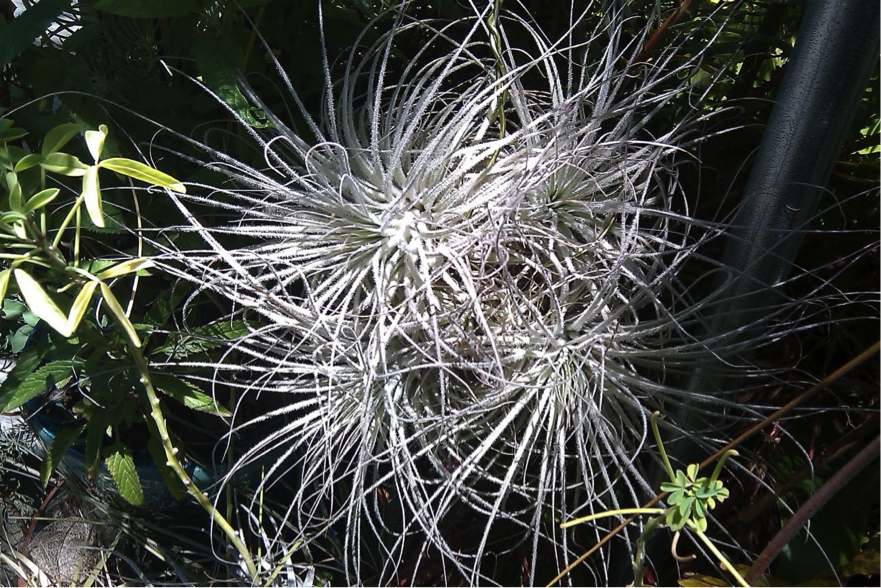
t. tectorum
BY LISA RINI
(All photos are Tillandsias from the author's garden, taken by the author)
I am certain every person reading this article has a favorite plant, and that favorite plant is a prominent feature in their San Diego garden. Having gardened in San Diego for over 40 years, I can tell you that collecting and trying all different types of plants has always been a huge part of my life. As soon as I retired from my position with the city of San Diego – I became a master gardener and then a landscape designer. After all, we can garden 24/7 here all year long – and I want to take full advantage of that! San Diego is truly a great place to live if you love plants!
My plant collection has grown exponentially over the years. When a vendor at an orchid show displayed tillandsias at her booth over 30 years ago – she handed me a business card with plant care guidelines on 4 lines – I was smitten immediately! Here was a plant that required no soil or growing medium, and could be suspended anywhere in the garden with no demands for anything besides light, air and a spray of water. Perfection! Thus began the tillandsia phase of my plant collection – I have never looked back!
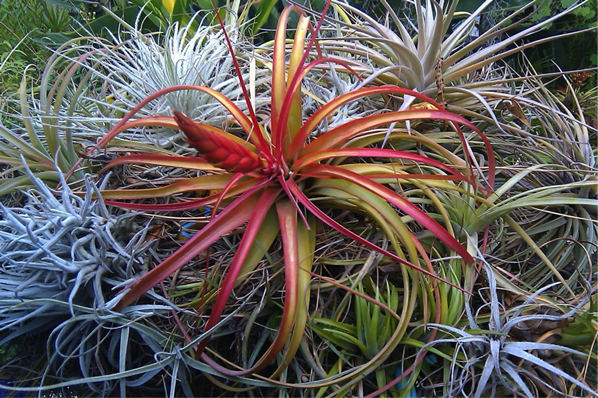
t. concolor
Tillandsias have become my absolute favorite plant. I have thousands in my garden – thriving in a wide variety of microclimates just east of Interstate 15. Before you are overwhelmed with the thought of so many plants – know that a tiny little 5 inch cluster can have over fifty pups attached together; but there are other varieties where a single plant (called a pup) can be 2 feet across. The diversity of these plants is amazing. Tillandsias can be gray, green, variegated, or even change colors throughout the year to include reds, pinks, purples and more. They can have thick or thin leaves, some are smooth, others feel furry, some are grassy looking – others are rigid. Some of them break easily if mishandled, others can fall on the ground or can be tossed around and not show any damage. Some bloom close to the center of the plant, others send up glorious spikes that are perfect natural feeders for hummingbirds. Some prefer humidity, others like it dry; some like shade, others like full sun; some like a good soak periodically in a tub of water with fertilizer, others prefer a spray of water every few days. The only thing every variety of tillandsia consistently needs – is air – which is why they are often referred to as “air plants” when you see them available for sale.
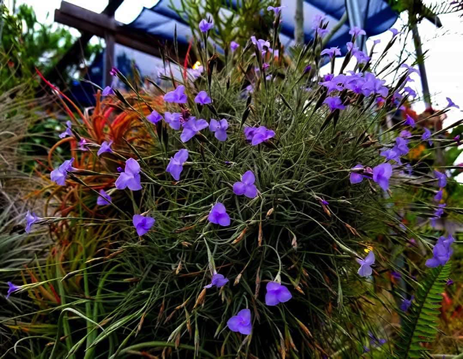
t. mallemonii
How did these become my favorite plants? Besides the incredible diversity within the tillandsia family, and the ease of care (you’ll feel better after I share care suggestions below), they are also phenomenally easy to add to the garden! As a designer – I am always looking for texture and visual interest to add to the vignettes I am creating. Tillandsias are incredibly versatile because they can be tucked into almost every plant grouping and look like they have always been there – and the placement of a tillandsia can take less than 5 seconds! Really! It’s like magic to see how much they can add with so little effort.
Let me share some of my general tips with you on caring for tillandsias. I realize with the huge variety of tillandsias available – it may sound daunting – but know the ones you buy in the big box stores and local nurseries tend to have similar care requirements. As you increase your knowledge, skill level and success rate with these plants – you will have plenty of opportunities to grow your collection thanks to the terrific tillandsia growers in the region (see the list at the end of this article). Also consider membership in the San Diego Bromeliad Society to learn more about these plants, and attend their regular sales throughout the year!
HELPFUL HINTS FOR GROWING TILLANDSIAS FOR SOUTHERN CALIFORNIA
- Use tillandsias throughout the garden – tuck in other woody plants, place on driftwood or wire baskets, attach to cork using tillandsia glue or fishing wire, hang in wire baskets or with colorful wire, or consider grouping tillandsia varieties together that have similar microclimate requirements. Location options are only limited by your imagination and your available space!
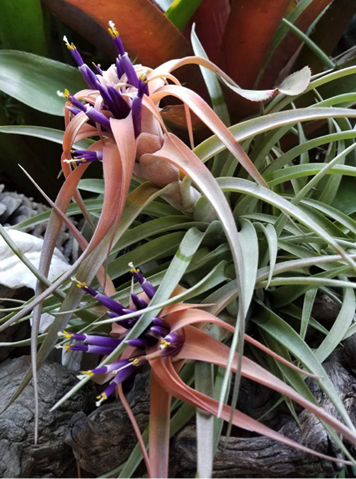
t. peach capitata
- Pups can range in size from very small (less than an inch) to a large specimen (12 inches or more for a single plant) and even extra large specimens from growers. You can also select a tillandsia cluster (available from growers or at Bromeliad Society sales) which will be denser and often includes the mother plant. Clusters need space for good airflow and may need a more substantial container (e.g., heavy duty wire basket). The blooms can vary from just a small bloom in the center of the plant to a spike that is several feet tall. All of these factors will impact the space requirements for these plants.
- Your aesthetics (or how many plants you have) may impact how much or how frequently you groom the plants. If there are broken tips – you can trim them off and the plant will look refreshed. Spent blooms (e.g., if they turn brown and are no longer attracting birds) can be trimmed off close to the tips of the plant leaves. Lower leaves can become brown and may even hold water close to the roots of the plant – lift the plant gently from its perch, pull off the lower leaves or remove spent mother plants, and then place the plant back into your garden. I like to do this once a year for all my plants to ensure they are healthy and pest-free.
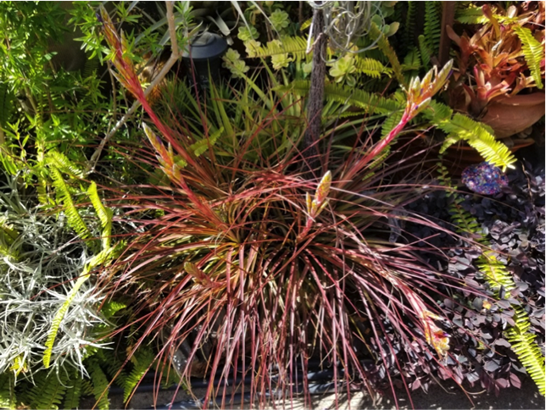
t. juncifolia
- Most of the common tillandsias that are easily available for purchase prefer to be grown as “air plants” – without pots or growing medium. (These are my preference because of how easy they are to place in the garden.) But if you purchase a tillandsia that is planted in a pot – you can leave it in that mix as is, or if you prefer, plant it in a different container using my preferred growing medium: orchid mix (usually a soil-less mix of peat/bark/perlite), or a soil designed for cactus/succulents. Tillandsias that prefer being in pots can actually be added to succulent containers or planted in fast-draining soil in the ground.
- Microclimate considerations:
- AIR – Although these plants can be used for a short time inside for a centerpiece, tillandsias want to be outside and do best in areas with good airflow.
-
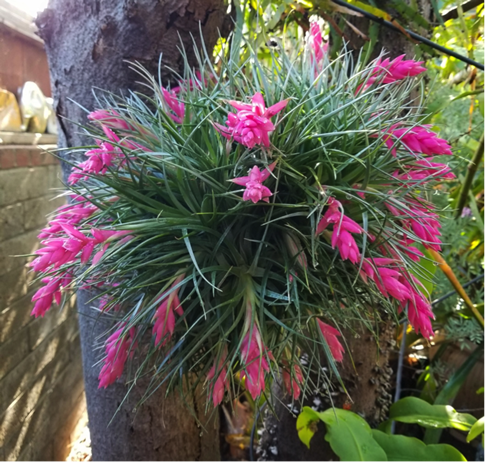
t. stricta
WATER – These plants do need water. In warm months – I spray all of mine gently every few days with a hose so that the entire plant gets wet. One precaution is that the plants should dry off in about 4 hours. Some of the larger plants can be tipped on their side to let the water drain off the plant. Note: tillandsias that are overwatered can rot. If a plant is underwatered, their leaves turn inward, look wilted, or lose color. Another option for watering is to dunk the entire plant in a bucket of water once a week. Collectors and growers (who do not want to use tap water) actually filter the water they use on their plants; some people use only rain water. Misting is ok on really warm days – but a regular water schedule for your microclimate where the entire plant gets wet and dries off is the best. A quick gentle spray from the hose is usually sufficient.
- LIGHT – Most tillandsias respond well to partial sun/bright growing conditions. Similar to orchids, I find that those in shade bloom less and have much less color than those getting adequate light. There are tillandsias that prefer full sun (in the coastal-influenced areas), partial sun (most tillandsias), or shade. The plants are so easily moved, if you notice any problems (underperforming or pests), you can easily remove damaged leaves and move the plant into another area of your garden. Morning sun is fine for many tillandsias – but if you see burn marks – move the plant!
-
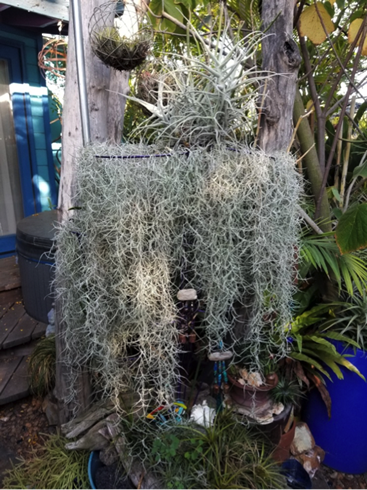
t. spanish moss
TEMPERATURE – Most tillandsias do best with some humidity, good airflow, and adequate light. But extremes in temperature do affect the plants: cold air means the plants will take a long time to dry and could lead to rot; hot dry winds can also cause the plant to dry up too quickly. Ideally temps should be in the moderate range.
- FERTILIZER – Tillandsias do benefit from fertilizer. You can purchase fertilizer specifically created for tillandsias (where they sell the plants) and follow the instructions on the label. Some collectors use fertilizer throughout the growing season of the plants. You can apply using a hose applicator or put the fertilizer in the bucket of water if you use that method to water your plants. I use hose-sprayed fertilizer about 1x/year.
- PESTS – Gratefully, tillandsias are usually pest free! However, if plants do NOT get the air/water/light they need – they can get mealy bug, scale, etc. The worst damage (rot) comes from overwatering. The other challenge I have had is when hungry rats or rabbits are in the garden – they each have some of their favorite plants to munch. Rabbits eat the leaves down to the soil; rats (sharpening their teeth) chew off the roots of more fibrous tillandsias. If you have rabbits – move tillandsias above ground level. To discourage rats, increase trapping efforts, and move plants to higher well-lit locations.
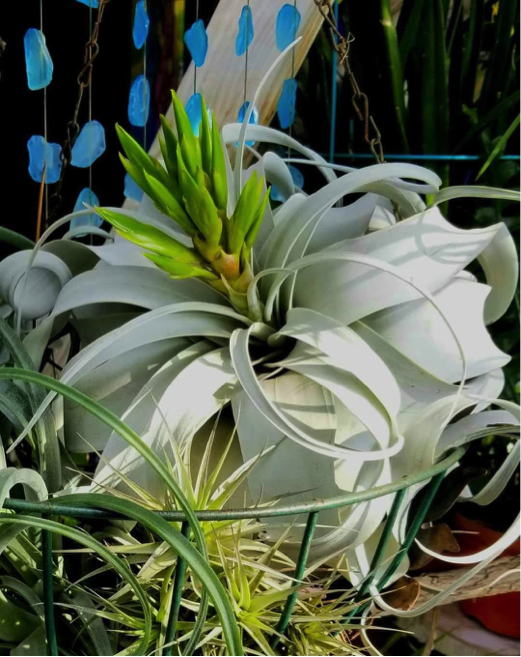
t. xerographica
Can you kill a tillandsia? Absolutely – but I also know if I can locate the right microclimate in my garden for each tillandsia – I will most likely have success. Since placement in the garden is so easy – I am always willing to move them around, and try new and different varieties. Plus I have learned over the years which varieties are happiest here – and those are the ones that I return to time and again! I hope you give tillandsias a try – they are truly wonderful minimal care plants for southern California gardens!
RESOURCES FOR TILLANDSIAS
Wholesale, Retail and Mail Order
CLAIREMONT MESA - https://cuffelfarms.com/
ENCINITAS - https://www.birdrocktropicals.com/
LEUCADIA - https://shop.wholesaletillandsias.com/
TORRANCE - https://www.rainforestflora.com/
Mail Order only
Retail only
Limited selections are available in most local nurseries as well as big box stores
Rini has been a San Diego Master Gardener since 2010 and San Diego Garden Concierge.

